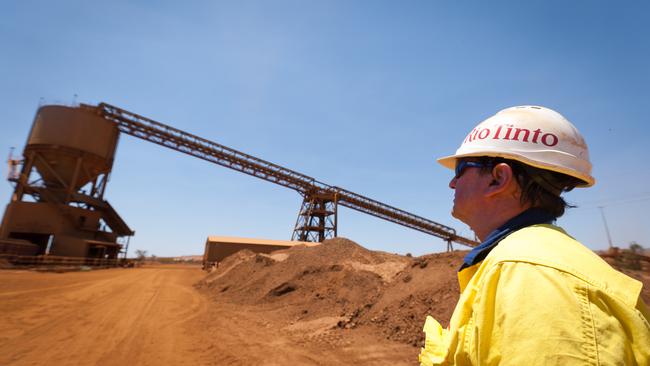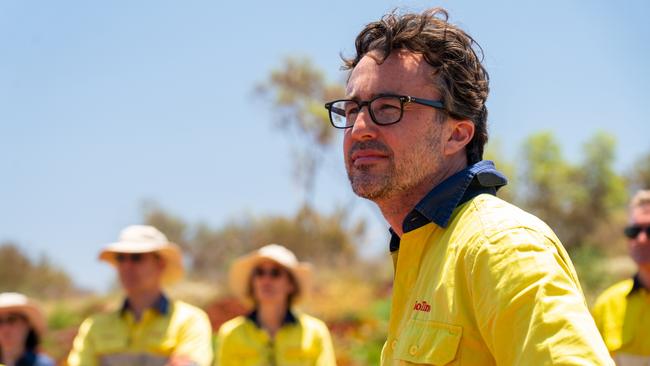Rio Tinto to blend iron ore amid content quality concerns
Rio Tinto is set to blend Australian and African iron ore at ports in China from next year to address concerns about the declining quality of the product from ageing mines in Western Australia.

Rio Tinto is set to blend Australian and African iron ore at ports in China from next year to address concerns about the declining quality of the product from ageing mines in Western Australia.
The producer’s iron ore boss, Simon Trott, flagged the move amid challenges with mines in the Pilbara and with ore from the high-grade Simandou mine in Guinea scheduled to start flowing into China next year. Mr Trott said blending ore from Simandou – once dubbed the Pilbara killer – could be a solution to Rio’s ongoing problems with maintaining the iron content of exports from WA.
Rio has flagged a review of its product mix as it wrestles with having to ship higher volumes of lower-grade material, known as SP10, from the Pilbara.
The struggles raise the prospect of Rio’s vast Pilbara operations losing their long-held status as the key supplier of benchmark 62 per cent iron product. High-grade ore from Simandou would be blended with Pilbara ore at portside in China under the plan.
Rio already does some portside blending in China, including using the much smaller volumes of ore from its Canadian operations, which after processing have an iron content of about 65 per cent, and other sources.
The company’s portside sales in China totalled 20.4 million tonnes in the first nine months of 2024, up from 17.5 million tonnes over the same period last year.
At the end of September, inventory levels were 8.1 million tonnes, including 5.6 million tonnes of Pilbara product.
In the nine months to the end of September, 90 per cent of Rio’s portside sales were either screened or blended in Chinese ports.
Mr Trott said the portside operations in China had been set up with an eye to the start of production at Simandou.
“We’re already taking material, Pilbara, IOC (Iron Ore Company of Canada) and third parties (for portside blending),” he said.
“Simandou coming on gives us another bow to the portfolio, and so it’s time to have another look at it and say what is the best way across all of our assets going forward to present those products to market.”

Rio expects to ship 323-338 million tonnes of iron ore from the Pilbara in 2024, but has said it will export higher volumes of lower-grade ore until replacement mines come on line.
The Simfer mine at Simandou will build up to annual production of 60 million tonnes, with Rio’s share 27 million tonnes, by 2028.
The company is pinning its high-grade hopes in the Pilbara on the staged development of the Rhodes Ridges project through a deal with billionaire Angela Bennett and other members of the Wright family currently locked in a high-stakes legal battle with Gina Rinehart over royalty rights to Rio iron ore mines.
Rio is working on plans to have Rhodes Ridge in production before the end of the decade with initial capacity of up to 40 million tonnes a year.
In the meantime, Rio expects the new Western Range mine to start production next year, followed by extensions to existing operations at West Angelas, Hope Downs, Brockman and Nammuldi.
Iron ore prices slumped more than 30 per cent between January and September as the Chinese property market tanked, with softer demand raising the prospect of heavy discounting for lower-grade product. Mr Trott said Rio, which celebrated the shipment of 4 billion tonnes of iron ore from the Pilbara to China in July, was like other miners in that it had tapped the best deposits first.
“So, grades out of the Pilbara from our business and across the board have declined,” he said.
Mr Trott said Rio had maintained its flagship Pilbara blend product for about 20 years and it was now time for a review of its strategy.
Analysts pointed to BHP facing grade problems in the Pilbara after it received lower than expected prices for its iron ore in the September quarter.
BHP boosted iron ore production from its mines in WA in the three months to September 30, but prices fell 12 per cent on the previous quarter and were down 18 per cent on the same time last year.
Mr Trott, who spoke at the Melbourne Mining Club on Friday, said Chinese steel demand had reached a plateau, but it would remain a huge market for iron ore producers.
“Property is weak, and it will continue to be weak because of where that economy is at in terms of its maturity,” he said.
“So far that has been offset by manufacturing, which has been pretty strong, and infrastructure.”
Mr Trott said on the plus side other market, particularly India, were growing.



To join the conversation, please log in. Don't have an account? Register
Join the conversation, you are commenting as Logout